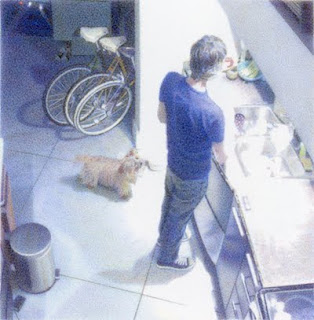One Day at Rest, Untitled 19 (10:30 pm) 2015 5.5x8" acrylic on board
I completed my project ‘One Day at Rest’ on December 31st, 2015. It began on July 2nd, 2011 when four GoPro cameras recorded more than 7200 digital image files of a day in our life. Twenty of those files were used to compose ten paintings and ten drawings, illustrating the events of that day.
I spent four and a half years immersed in the minutiae of a single, largely insignificant day while the tumult of the present pressed on. I wanted to confront and contain the impermanence of an average day of an average weekend at a particularly unremarkable time in our lives, to arrest the relentless trudging towards the unknowable future.
While I painted and drew, the planet we inhabit completed more than four revolutions of our sun. It rotated on its axis 1643 times. I broke my arm, I lost a tooth. My mother died, my dog died. I lost a gallery in New York and gained two in Canada. I participated in six group shows and had one solo show. I sold one painting. We moved 550 kilometres down the road from Montreal to Toronto, my sixth move in nine years. I began to make peace with the ghosts of my hometown after twenty six years away.
One Day at Rest, Untitled 17 (9:26 pm) 2014 5.5x8" acrylic on board
With the project completed, I emerge from a kind of mental exile, reengaging with my art world brain, with what happens after the work is done. What to do with this body of work? Do I want to sell it off piecemeal? Do I want to sell it at all? Would anyone buy it? Do I even want to share it with anyone?
I’m conflicted about what I want from my life as an artist. More so after thirty years than at any time before. Perhaps it’s just the confident ignorance of youth petering away, diluted by the disillusioning realities of the art world or my own warring desires of notoriety and obscurity.
Working for so long in isolation, I alter between states of grandiosity: ‘This is the best work I’ve ever done, no one is doing work like this!’ and hopelessness: ‘I’ve wasted my life, no one will care about any of this, I don’t even care about it!’. In the end comes ambivalence: neither, nor. Any remnant desire I might have had for some unspecific personal transformation slowly evaporates with the completion of the project.
In times of stress, an image often floats into my mind of myself as a child. It feels like loss. I’m in the basement of our house in Toronto. It’s summer, and in the cool relief of that crudely appointed space I quietly assemble a model car. It’s an image from the seemingly endless solitude of an afternoon in July or August. I imagine that I’m aware neither of the past, nor of the future. I’m content to hide from the sun, from my peers, from the neighbours. I will always be in this moment and I will live forever.
One Day at Rest, Untitled 18 (9:06 pm) 3x3" coloured pencil on board
I’ve spent much of my life trying not to participate. Trying not to be noticed, hoping to be left alone. So much of my childhood was spent trying to cope with the insidious, if intermittent turmoil of the family around me. I coped by retreating in to myself, by assembling models, by drawing, by watching television, by removing myself as much as possible from the physical world outside our doors.
I never wanted to leave the house. I created an unchanging landscape of days that made solid a ground that always seemed to be in threat of shifting, of altering for the worse in some irreparable way.
I’ve lived most of my life not far from this self-protective shell. I seek comfort in routine and greet change with reluctance and suspicion. Despite knowing that the only constant in life is the endless, shifting cycle of decay and renewal, and despite having the dark knowledge of my own inevitable demise, I subconsciously believe that my routines will make me immortal: If you can make one day much like the next, then surely this chain of days can push endlessly ahead, slowing time to a crawl.
In my late fifties, I’m more aware than ever of the ticking of the clock, of the pages flying from the calendar as in an old movie. I continue to impose routines on my life, sometimes to the detriment of my relationships and never to any great effect.
For the last four and a half years, the child in the basement stopped time. He made a day in 2011 last until the final hours of 2015. Whatever the outcome of my reengagement with the present, I can say at least in that regard, that the project was a success.
One Day at Rest, Untitled 20 (10:04 pm) 3x3" coloured pencil on board





















